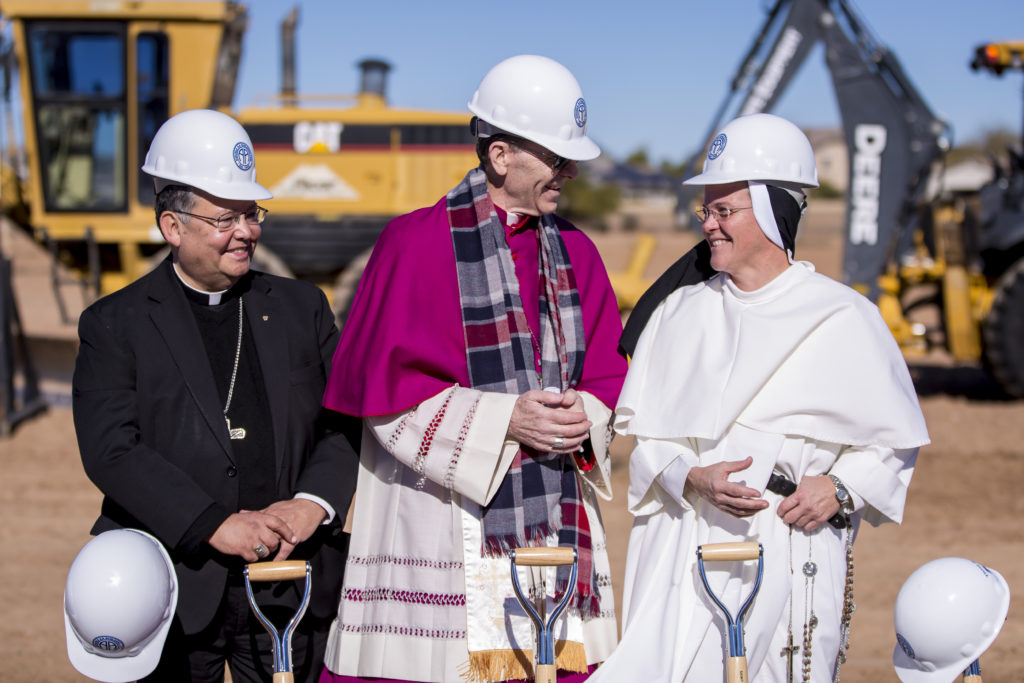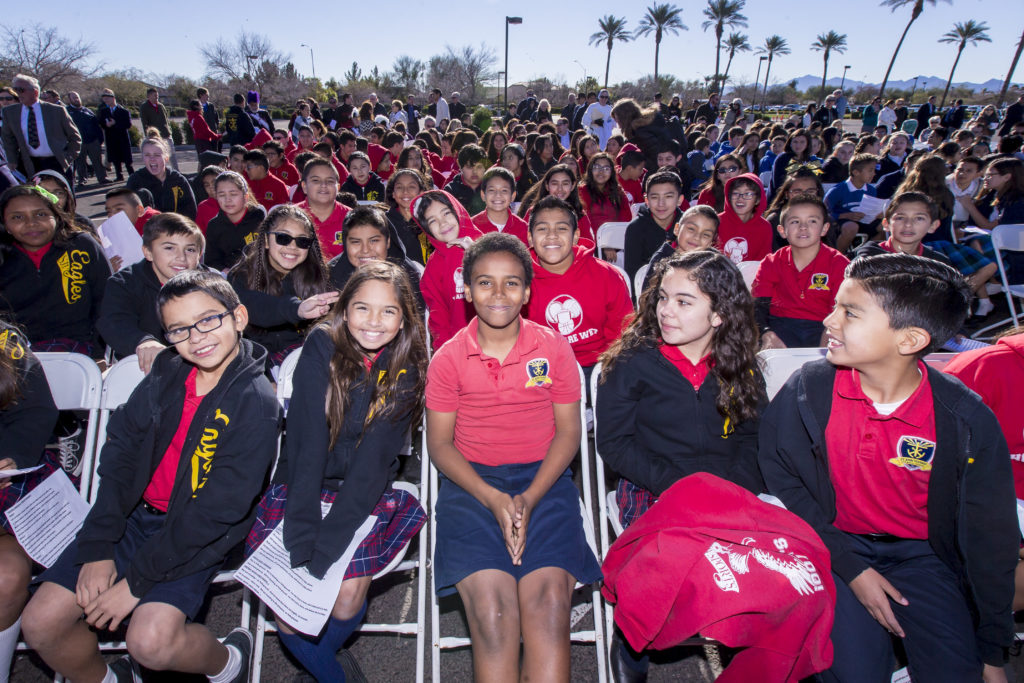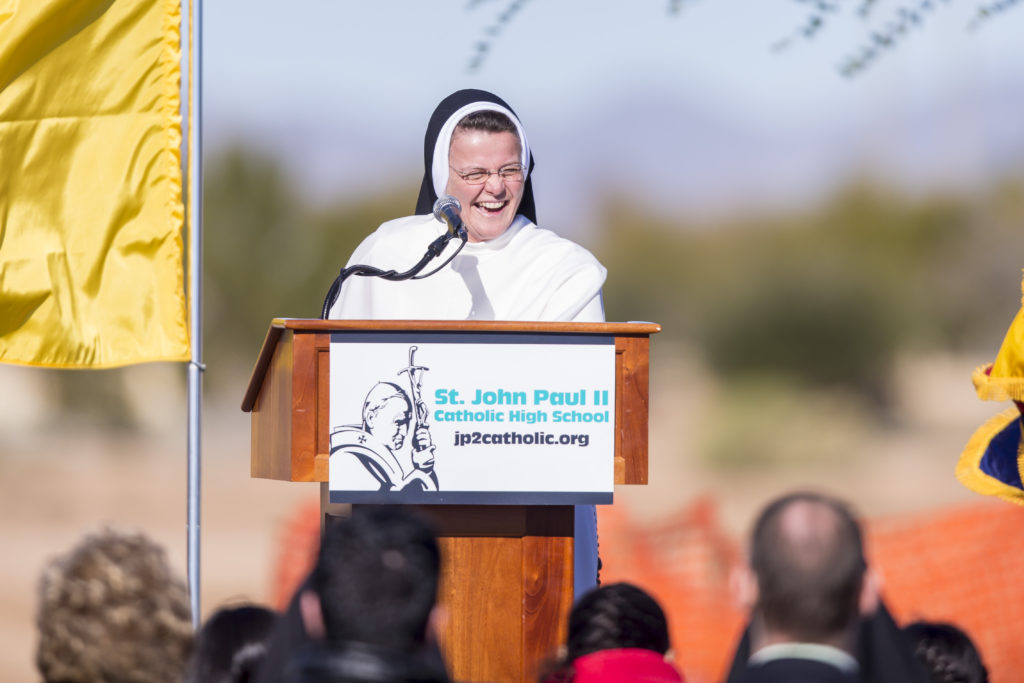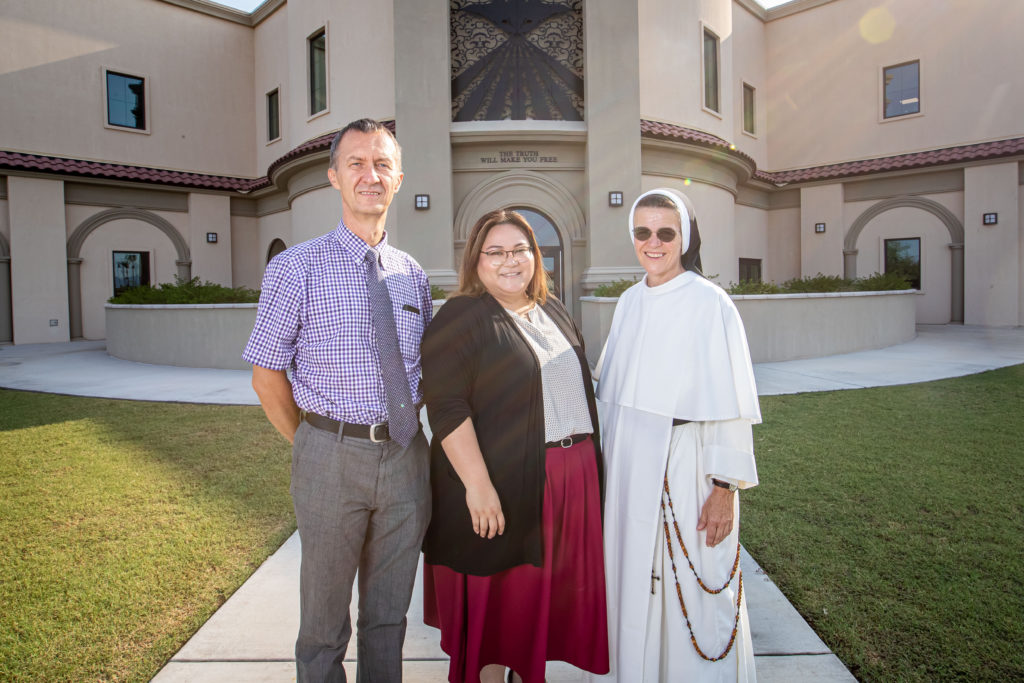
By Joyce Coronel, Together Let Us Go Forth ~ Juntos Sigamos Adelante Magazine
It began with an invitation from Christ: to become totally His as a consecrated religious sister. Thirty years ago, Sister Mary Jordan Hoover, OP, said yes and entered the Dominican Sisters of St. Cecilia.
“I was attracted to living a life that was for Christ and I also enjoyed the prayer life and the history and the traditions of the Dominican Sisters of St. Cecilia.”
Founded in 1860, the well-established community is devoted to Catholic education. Sister Mary Jordan served in four other dioceses before being invited by Bishop Thomas J. Olmsted in 2015 to come to Phoenix and establish a new Catholic high school.

Did you know?
The Dominican Sisters of Saint Cecilia, commonly referred to as the “Nashville Dominicans” due to their historical roots in the city dating back to 1860, are acclaimed for their expertise in Catholic education and for their academic and spiritual leadership.
The mission of St. John Paul II Catholic High School is to provide an educational environment that promotes a personal encounter with Jesus Christ through prayer, study, community and service as disciples.
All members of the class of 2021 were accepted into a college or university. The class of 2021 was the high school’s first graduating class and received $2.2 million
in scholarships.
Situated in Avondale on the far west side of the sprawling metropolis of Phoenix, St. John Paul II Catholic High School opened its doors in 2018 with Sister Mary Jordan as its principal. Three other sisters from her congregation serve at the school as well.
Six months prior to breaking ground for the school, Bishop Olmsted issued an apostolic letter on Catholic education, setting out five ways Catholic schools assist the Church in the mission of evangelization. Sister Mary Jordan said the diocese’s newest high school embodies each of those elements, particularly through a curriculum that is imbued with Catholicity and is focused on the dignity of the human person.
Teachers themselves must have a vibrant, personal relationship with Christ and be willing to embrace what the Catholic Church has said about schools, particularly as outlined in Bishop Olmsted’s apostolic letter.
“Sometimes people go to a Catholic school for a secular reason,” Sister Mary Jordan said. Worldly success might be more readily gained with a Catholic school’s stronger academics and the greater opportunity to participate in sports is also attractive. But that’s not what animates St. John Paul II.
“This school wasn’t founded with the end being improving the opportunities for worldly success for our students,” Sister Mary Jordan said. “The common themes throughout time relate to what the Church has said about Catholic education and what it should be.”
That includes being inspired by supernatural vision.
Discipleship and evangelization
By the numbers
Number of students at St. John
Paul II Catholic High School: 333
Number of staff and faculty: 42
Motto: Veritatis Splendor — The Splendor of Truth
Mascot: Lolek the Lion (Team nickname is the “Lions”)An estimated 99 percent of Diocese of Phoenix Catholic school students graduate from high school; 97 percent go on to attend college.
This past school year, Diocese of Phoenix K-8 schools had 9,260 students enrolled. High schools had 5,050 (including Brophy College Preparatory, which is Jesuit-owned).
“My living of the charism of my community animates and gives life to this school. It’s a supernatural life,” Sister Mary Jordan said. “So, in a sense, when you’re talking to Dominican Sisters of St. Cecilia, the four of us living in this community, our charism is present here at St. John Paul II because we are present.”
The Dominicans, known as the Order of Preachers (hence the OP after members’ names), have a particular call to share the Good News.
“I’m preaching the Gospel through my life and through my words here at St. John Paul II, but also when I’m walking down the street or if I’m going to Mass at St. Thomas Aquinas or going to the grocery store,” Sister Mary Jordan said.
Each day dawns with personal prayer and meditation. And that’s mirrored at the school she leads.
“Every class begins with prayer. The chapel in our school is located right in the middle of the main academic floor, and so Christ is the center of our school building and He’s the center of our lives.”
Dariusz Serwach, who teaches math and has been on staff since the school opened, agreed.
“In public school, you cannot teach about Jesus, so it’s a very secularized system,” Serwach said. “Here, God is the center of our education in every element.
That means shaping students spiritually.
“Yes, we need to prepare them to earn their living, but also we prepare them to become disciples of Jesus Christ which is so needed in our world at this time.”

Cristina Martin, who teaches science at St. John Paul II, taught in a public school for seven years.
How does a Catholic school evangelize?
In five ways:
- A place of encounter with the living Jesus Christ (prayer)
- To be places of Spirit-filled community (community)
- To impart a Catholic worldview through the curriculum (study)
- To assist students in becoming free (formation)
- To send students out as missionary disciples to transform the culture” (service)
- Bishop Thomas Olmsted, Evangelizing through Catholic Schools, 2017
“A major difference is just how much our school life is intermeshed with our faith life. It’s refreshing to be able to not only interact with my students on the spiritual level as well but also feel free to do things like mentor and describe things in terms of my own faith and my own vocation and not feel concerned about overstepping any boundaries.”
Kelly and Tommy Umbdenstock’s eldest son, Hayden, is a sophomore at St. John Paul II.
“You can tell the minute you get on the campus you are very welcomed but it centers around faith.” Kelly said. The school’s chaplain has an office in the cafeteria, “so whenever the kids need to come to him, he is always available.”
The “Together Let Us Go Forth ~ Juntos Sigamos Adelante” campaign made the school possible, dedicating $23 million toward the building and establishment of the campus.
At a time when dioceses across the nation are shuttering their schools, the advent of St. John Paul II is a beacon of hope and a highway to evangelization — and the future of the Church.
“We need to be sure we’re providing the kind of Catholic education that will help new leaders emerge already as teenagers but then continue to grow in their faith and in their witnessing to Christ,” Bishop Olmsted said.
“People ask me, ‘How are we going to know if the school is successful,” Sister Mary Jordan said. “To be able to be evangelizers means that when our students graduate, they will have a desire to continue to grow their relationship with Jesus Christ, that they will want continued encounters with Our Lord in their life, and then they will want others to encounter Him as well. And that’s what it means to be an evangelizer. All of us who are baptized are called to evangelize. Baptized Christians are called to go out and bring other people to the Lord. That’s how we’re going to know that this school is successful.”

We invite you to participate in discipleship and evangelization efforts at the Diocesan level, including the Together Let Us Go Forth ~ Juntos Sigamos Adelante campaign, the Charity & Development Appeal, the TV Mass, Catholic School Support 365, and through supporting our seminarians and Nazareth House. If you would like to receive the magazine at your home, we invite you to support the mission by participating in one of these efforts. You may also call our donor services team at (602) 354-2235 to receive future issues or provide one of our team members with an updated address.







